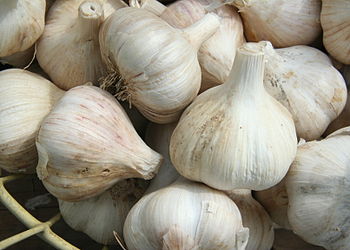Garlic breath

Garlic breath is halitosis (bad breath) resulting from the consumption of garlic.
Causes
[edit]The major volatile compounds responsible for garlic breath are allyl methyl sulfide, allyl methyl disulfide, allyl mercaptan, diallyl disulfide, dimethyl disulfide and methyl mercaptan, along with minor amounts of dimethyl selenide.[1][2][3] Various other sulfur compounds are also produced when allicin in garlic is broken down in the stomach and liver. Out of the many compounds, allyl methyl sulfide (AMS) does not break down quickly and remains in the body in significant amounts hours after consumption, resulting in an odor that can last for hours — or even for as long as two days.[4] AMS is the only one of the garlic-derived organosulfur compounds detectable in the lungs or urine, as well as the mouth, which means that AMS is reabsorbed into the blood stream and travels to other organs for excretion - namely the lungs, kidneys and skin.[5] Anaerobic bacteria, which do not metabolize oxygen, are a main source for producing volatile sulfur compounds (VSC) which cause bad breath.[citation needed]
Remedies
[edit]Mouthwash or breath mints are not particularly effective, since the sulfurous compounds are absorbed into the bloodstream, and exit the body through the lungs and skin. Consuming parsley is a common folk remedy.[6] Studies conducted at Ohio State University have shown that drinking milk can reduce garlic breath.[3][7] Lettuce, chicory, celery, potato, parsley, mint leaves, peppermint, and basil were shown to be the best remedy according to the study.[8] Eating these foods raw is more effective than heated. Indeed, enzymes that degrade the sulfurous compounds responsible for garlic breath are heat sensitive and found in previously mentioned food.
References
[edit]- ^ Cai, X.-C.; Block, E.; Uden, P.C.; Quimby, B. D.; Sullivan, J. J. “Allium Chemistry: Identification of Natural Abundance Organoselenium Compounds in Human Breath after Ingestion of Garlic using Gas Chromatography with Atomic Emission Detection”, J. Agric. Food Chem. 1995, 43, 1751-1753. doi:10.1021/jf00055a001
- ^ Block, E. (2010). Garlic and Other Alliums: The Lore and the Science. Royal Society of Chemistry. ISBN 978-0-85404-190-9.
- ^ a b Hansanugrum, Areerat (2010). "The Effect of Milk on the Deodorization of Malodorous Breath after Garlic Ingestion". Journal of Food Science. 75 (6). Ohio State University: C549-58. doi:10.1111/j.1750-3841.2010.01715.x. PMID 20722910.
- ^ Singh, Maanvi. "Science Of Stink: Blame Sulfur Compounds For Your Garlic Breath". National Public Radio. Retrieved 6 January 2016. This appears to be anecdotal evidence. The reporter has quoted it from chemistry professor Eric Block, PhD, and his wife. "I'm a garlic lover, and my wife — who has an excellent sense of smell — says even 48 hours after eating a garlic meal, she can smell it on my skin," Professor Block explained.
- ^ Suarez, F.; Springfield, J.; Furne, J.; Levitt, M. "Differentiation of mouth versus gut as site of origin of odoriferous breath gases after garlic ingestion," Am. J. Physiol. 1999, 276(2 Pt 1), G425–30.
- ^ Joe Graedon; Teresa Graedon (9 March 1998). "How to Kiss Garlic Breath Goodbye". LA Times. Retrieved 24 January 2012.
- ^ "Drinking a glass of milk can stop garlic breath". BBC News Health. 31 August 2010. Retrieved 26 May 2012.
- ^ Greenwood, Veronique. "The surprising foods you should eat to banish garlic breath". Retrieved 2017-01-17.
